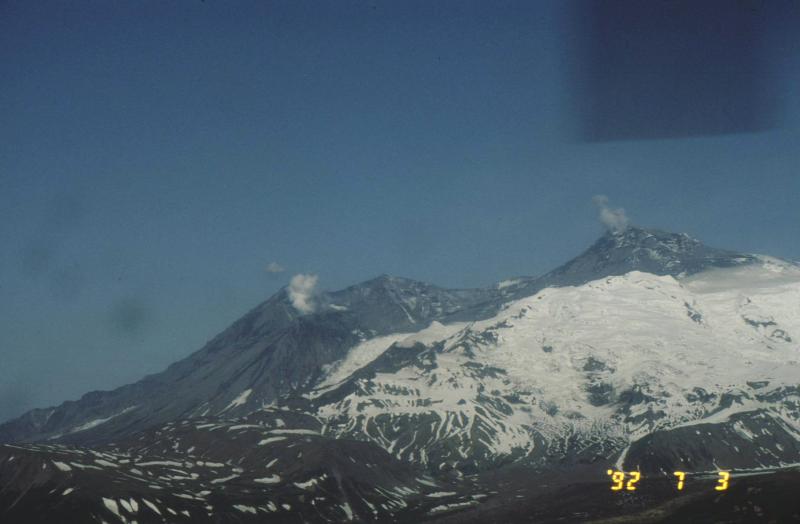
Mount Spurr Volcano six days after the June 27, 1992 eruption of its Crater Peak vent (darkened, steaming cone at lower left). The tephra fall and ash cloud traveled almost due north from Crater Peak, darkening the glacier-covered true summit of Mount Spurr (steaming peak at right) and dusting climbing routes on Denali in the Alaska Range. Crater Peak erupted two more times in the summer of 1992. Spurr is the closest volcano to Alaska's largest city of Anchorage - only 80 miles east of the volcano.
Volcano(es): Spurr
Photographer: Miller, T. P.
URL: avo.alaska.edu/image/view/13202
Credit: Image courtesy of AVO/USGS.
Use Restriction: Please cite the photographer and the Alaska Volcano Observatory / U.S. Geological Survey when using this image.
Full Resolution.
Crater Peak 1992/6
For 220 pages of information on the three 1992 eruptions of Crater Peak, please see the USGS Bulletin 2139, available online at: https://www.avo.alaska.edu/pdfs/B2139.pdf ; this file is 9 MB.
From McGimsey and others (1995): "On June 27, after 39 years of quiescence, the Crater Peak vent on Spurr volcano began the first of 3 eruptions (June 27, August 18, and September 16-17) in 1992 (Alaska Volcano Observatory, 1993; Eichelberger and others, 1995). The eruption was preceded by 10 months of gradually increasing seismicity that culminated in 19 hours of precursory volcanic tremor. Upwellings in the crater lake and a color change from green to gray were observed three weeks prior to eruption onset. In response to increasing seismicity and changes in the crater lake, AVO issued an alert on June 8 and observatory scientists briefed local officials on June 17 about potential volcanic activity."
From Eichelberger and others (2005): "Seismic behavior changed ominously on June 24 when a tremor episode lasted 154 minutes, followed 12 hours later by a similar episode that lasted 142 minutes. Eight additional tremor bursts occurred within the next 8 hours. The weekly update of 10:30 a.m. Alaska daylight time (ADT) on June 26 reported 'well above normal' seismic activity but still cautioned that an eruption might not be imminent in view of an absence of long-period (LP) earthquakes. At about the same time, aerial observations of the crater revealed that the lake had almost completely drained and that several large rocks had impacted the resulting mud flat. At 12:04 p.m. ADT, tremor that was continuous and stronger than earlier bursts began. AVO formally issued a warning of level of concern color code Yellow at 4:30 p.m. on ADT and went on 24-hour duty. At 3:00 a.m. ADT on June 27, a swarm of VT (volcano-tectonic) earthquakes struck at 0- to 2-km depths beneath Crater Peak; their rate soon increased to about one every 2 minutes. Three LP events accompanied this swarm. Tremor amplitude abruptly doubled at 7:04 a.m. ADT. This increase in amplitude was later interpreted to represent the onset of eruption, although weather clouds prevented visual verification. At 7:16 a.m. ADT, AVO began an emergency calldown announcing level of concern color code Orange. About the same time, telemetry was lost from the seismic station 400 m from the vent and an Alaska Airlines pilot reported that an eruption plume had risen 5,000 m above the cloud cover. AVO announced color code Red at 9:10 a.m. ADT. Tremor amplitude gradually increased, peaking between 9:35 a.m. and 10:25 a.m. ADT and registering on stations more than 100 km away. Pilots estimated the plume at mid-morning as high as 9,000 m and the National Weather Service (NWS) measured a maximum plume height of 14,500 m with C-band radar (Alaska Volcano Observatory, 1993; Rose and others, this volume [USGS Bulletin 2139]). The tephra cloud moved northward and ash began falling on Denali National Park at 10:30 a.m. ADT. Debris flows swept southward down narrow drainages and entered the Chakachatna River in three places. Most debris followed the course of the 1953 lahar. At about 11:30 a.m. ADT, seismicity decreased abruptly and the eruption was over. Weather and steam obscured Crater Peak and the eruption plume track from aerial observation on the afternoon of June 27, but paths of the debris flows were visible on the lower flanks of the volcano (Meyer and Trabant, this volume [USGS Bulletin 2139]).
"At 9:00 a.m. ADT on June 28, the level of concern was downgraded to Yellow. Aerial observation revealed a black northward-broadening swath of tephra on snow fields and glaciers. Ash thickness was about 1 to 2 mm at Denali National Park and Manley Hot Springs, 260 and 420 km north of Crater Peak (Neal and others, this volume [USGS Bulletin 2139]). This region is sparsely populated and there were no other reports of tephra there. The ash cloud continued northward to the Beaufort Sea, then it turned southeast into Canada and the coterminous United States, where it became indistinguishable from weather clouds about July 2.
"The level of concern color code was downgraded to Green on July 8. This was done partly on the basis of greatly reduced seismicity and SO2 emission, but also on the basis of analogy to the single-eruption pattern of 1953. The downgrading to color code Green proved to be premature." The next eruption was on August 18, 1992.
Eichelberger and others (1995) state that the June 27, 1992 eruption produced 44 million cubic meters of tephra, with a Dense Rock Equivalent (DRE) of 12 million cubic meters.